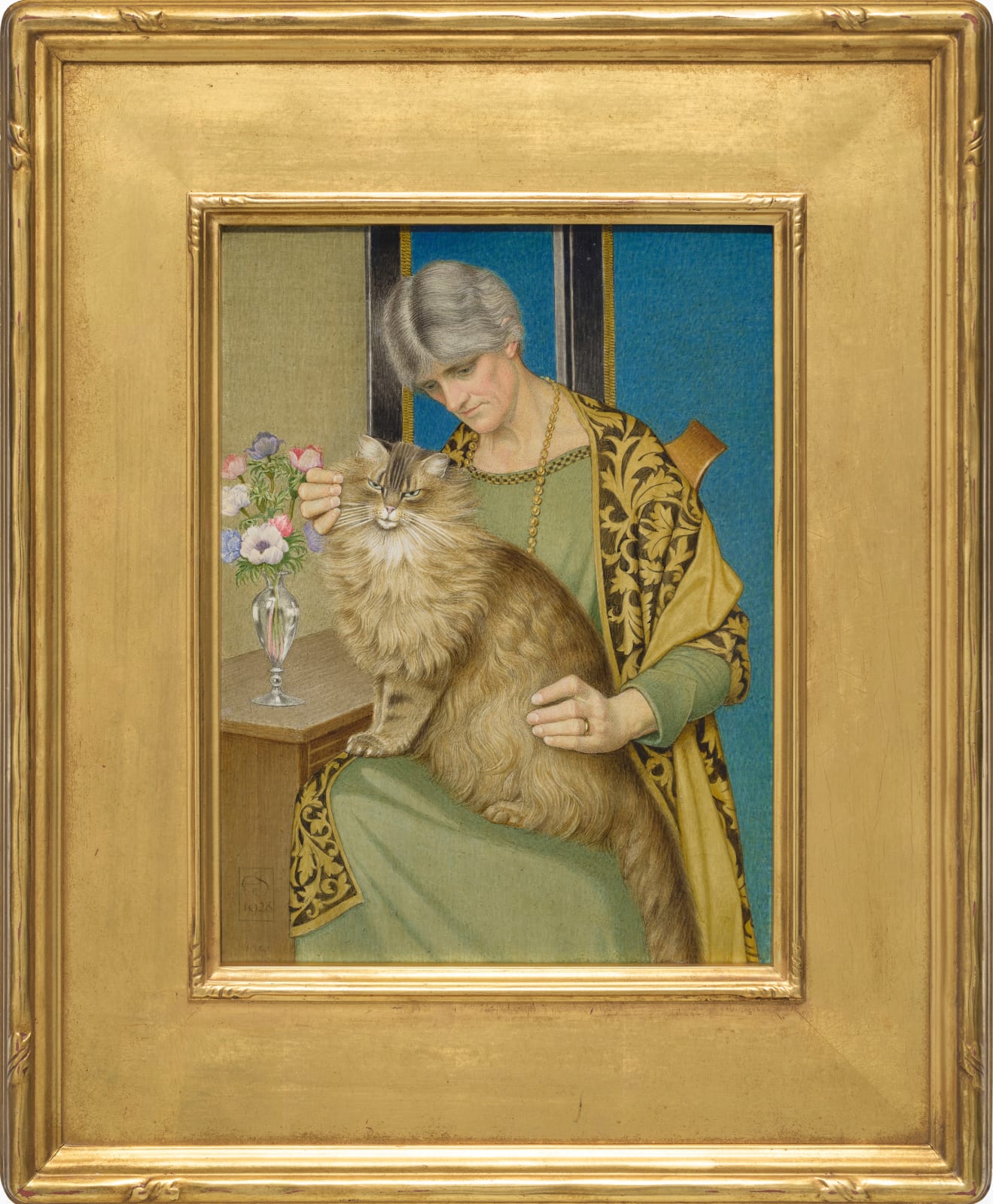Joseph Southall (1861-1944)
Inscribed ‘PORTRAITS OF BESSIE & TODDIE Joseph Southall 1928’ (verso)
Joseph Southall lived and worked in Birmingham at a moment of artistic and cultural excitement, making a substantial contribution to the local Arts and Crafts Movement. Largely devoted to painting, Southall also produced decorative arts in the true spirit of the artist-craftsman. Although there was no formal membership to the Birmingham Group of Artist & Crafts, it was simply unity of conviction encouraged by John Ruskin, William Morris and Edward Burne-Jones.
A visit to Italy in 1883 persuaded Southall to devote himself to highly-crafted paintings, reviving the use of egg tempera. In 1897, Burne-Jones sent Southall’s self-portrait in tempera, Man with a Sable Brush, to the New Gallery, along with his own work, establishing Southall as one of the foremost artists working in this medium at the time. Participating in exhibitions of the Arts and Crafts Society and Modern Paintings in Tempera, a precursor of the Tempera Society, Southall became one of their leading members. When the 1930 Winter Exhibition at the Royal Academy was devoted to Italian Painting, a renewed interest in tempera painting arose, resulting the following Summer Exhibition with an entire gallery devoted to works in tempera. Although Southall lived mostly in Birmingham, he exhibited internationally throughout his lifetime, at the Galerie George Petit in Paris in 1910.
Both sitters in Contentment are highly familiar to the artist: his beloved missus and kitten.[1] Southall and Bessie were first cousins who delayed marriage until well in their forties, in 1903, in order to avert offspring. His wife, Anna Elizabeth (“Bessie”) Baker, was herself a significant craftswoman, assisting Southall in his work and writing on the art of gilding. She appears in many of Southall’s pictures, including his celebrated double portrait in the National Portrait Gallery, London. As a childless couple, their feline family member may have played a significant role as Toddie is prominently portrayed.
[1] Two studies for Contentment were exhibited in the Birmingham show in 1980, op.cit., E12(i) and (ii). The pencil drawing, 27 x 20.1 cm., shows marks that indicate a transfer to the final version. A smaller watercolor, approx. 22 x 15.5 cm was a color study, showing green and rust-red fabric in the background instead of the present yellow and blue.
Provenance
Anna Elizabeth (Bessie) Southall-Baker (1859-1947), Birmingham
Her sale, Edwards, Birmingham, 23 March 1948, lot 249
Sotheby’s, London, 19 March 1979, lot 17
The Fine Art Society, London
Alan Fortunoff (1932-2000), New York
The Fine Art Society, London, 2005
Exhibitions
London, New English Art Club, Summer Exhibition, 1928, no. 99
Birmingham, Royal Birmingham Society of Artists, Autumn Exhibition, 1928, no. 143
Paris, Société National des Beaux-Arts, Salon, 1929, no. 1573
London, Leicester Galleries, Joseph Southall, 1931, no. 46
Birmingham, Royal Birmingham Society of Artists, Joseph Southall, 1933, no. 57
Birmingham, City Museum & Art Gallery, Memorial Exhibition of Works by the late Joseph Southall, 1945, no. 65;
London, Royal Watercolour Society;
Bournemouth.
Birmingham, City Musuem & Art Gallery, Joseph Southall, 1861-1944: Artist-Craftsman, 1980, no. E12;
London, The Fine Arts Society, 14 October – 7 November 1980.
London, The Fine Art Society, Sixty works by Joseph Southall, 1861-1944 from the Fortunoff Collection, 15 March – 16 April 2005;
Cheltenham, Cheltenham Art Gallery and Museum, 23 April – 4 June 2005.
Literature
‘Up Front’, The Observer Colour Magazine, 18 March 1979, p. 23
George Breeze, Peyton Skipwith & Abbie N. Sprague, Sixty works by Joseph Southall, 1861-1944 from the Fortunoff Collection, Fine Art Society, London, 2005, pp 98-99, no. 23, ill.



